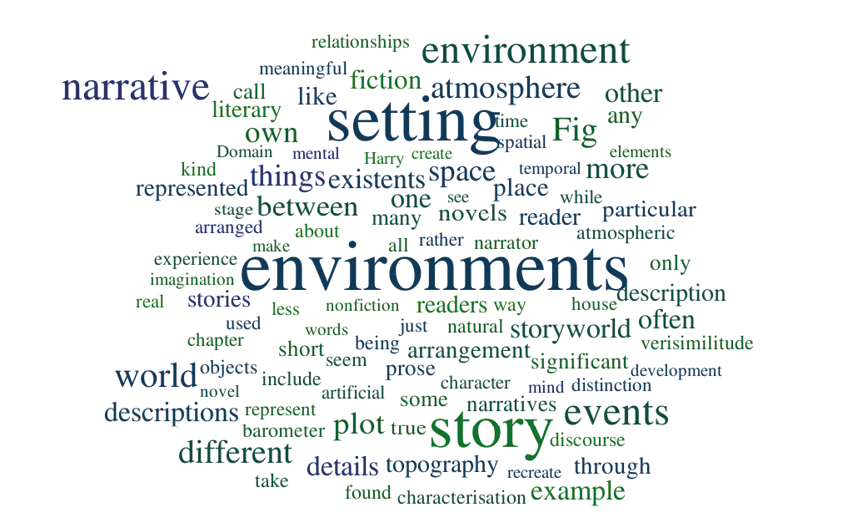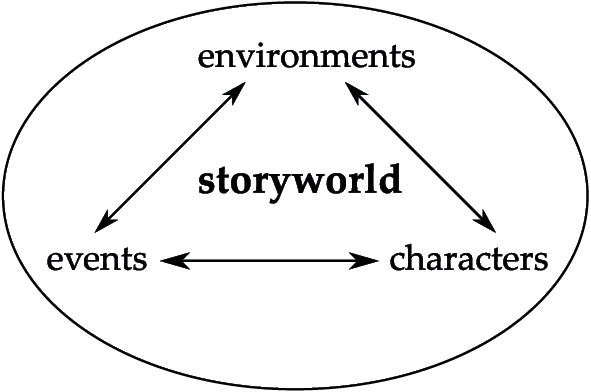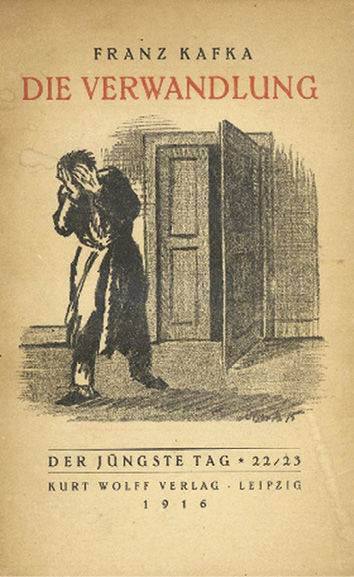
3. Setting
© Ignasi Ribó, CC BY 4.0 https://doi.org/10.11647/OBP.0187.03
As we have seen, the temporal dimension is represented in narrative by the plot, which is an arrangement of the events in the story. But what about the spatial dimension? How are the environments where these events take place arranged in narrative? What aspects of those environments are communicated to the narratee by the narrator? What is the relationship of narrative environments with the other existents of the story, characters and events? And how are literary narratives able to induce mental images of those environments in their readers using only words? These are some of the questions that we will try to answer in this chapter.
If plot is the meaningful arrangement of the events (temporal existents) of the story, setting can be conceived as the meaningful arrangement of the story’s environments (spatial existents). An existent in this context is simply something that exists, i.e. that is the case or has being, in a particular world. In our semiotic model of narrative, we distinguish three types of existents in any given storyworld: events, environments, and characters (Fig. 3.1).

Fig. 3.1 Relationships between existents in the storyworld. By Ignasi Ribó, CC BY.
In reality, however, things are not so simple. Rather than being two separate entities, space and time are intimately connected in what physicists call space-time continuum and literary theorists refer to as the chronotope.1 In English, we say that ‘events take place,’ reflecting the realisation that events can never happen separated from space, or rather from a particular place. In fact, the distinction between space and time is only an abstraction, an attempt to untangle and better understand the complex processes that make up our own lifeworld. Similarly, the distinction between environments (space) and events (time) in the storyworld should be taken as an abstraction to help us to understand the structure of narrative. Actually, both are intimately related and often intersect in complex ways.
And it is not just environments and events that are interconnected. In the previous chapter, when analysing the process of emplotment, we have seen some of the close connections that link events with characters. Similarly, environments and characters are also intimately connected with each other. Environments are more than just an objective background, or a stage filled with things (landscapes, buildings, furniture, etc.) where characters act. At a fundamental level, environments are the meaningful entanglements of characters with their own world, often represented in narrative as the subjective or psychological aspect of setting.
In this chapter, we will discuss in some detail how the environments of the storyworld are arranged in narrative. We will begin by defining what we understand by environment and the crucial role of environments in building the world of short stories and novels. We will then distinguish two basic ways to arrange environments into a fictional setting: as a topographical layout of natural and artificial things in space or as atmospheric relationships between those same things and the characters of the story. This distinction will allow us to present a typology with four major kinds of setting that may be found in prose fiction: irrelevant, functional, mental, and symbolic. We will then see how literary narratives use description to represent the setting and induce in the reader’s mind a vivid image of the storyworld. Finally, we will discuss the notion of verisimilitude and show how literary description can be used to encourage readers to read fictional stories as if they were happening in the ‘real’ world.
3.1 The World of Narrative
All narratives involve the creation of a particular world, the world of the story or storyworld, with its own temporal and spatial existents.2 Most often, this world is very similar to our own lifeworld. Things appear and behave just as they do in our everyday experience. When a character throws a pebble into a pond, the pebble bounces a few times and then sinks in the water. This is what we call realism, a principle of narrative discourse that uses our perceptions and assumptions about our lifeworld, which is often described as the ‘real world,’ to build, with more or less accuracy, the world of the story.
But the world created by narrative discourse can also be very different from our own. In a science-fiction short story, for example, the pebble that the character throws into the pond might rebound and fly out to space. Storyworlds are not necessarily bound by the same physical laws that seem to rule our world. They are alternative or possible worlds, configurations of space and time that may defy any aspect of common sense or our everyday experience.3 Fiction genres like fantasy, horror, or science fiction make much use of this worldbuilding capacity of narrative. But more realistic genres, such as romance, thriller, or comedy, even nonfiction books, also create their own storyworlds through the arrangement of the different existents of the story.
In most narratives, environments tend to be the existents of the story that contribute more directly to worldbuilding. An environment is everything that surrounds the characters, including landscapes, trees, animals, buildings, rooms, furniture, and any other natural or man-made objects or structures that characters may inhabit or move through.

Fig. 3.2 Cover of an early German edition of Franz Kafka’s The Metamorphosis (Die Verwandlung, 1915), Public Domain, https://commons.wikimedia.org/wiki/Category:Kafka_Die_Verwandlung#/media/File:Kafka_Verwandlung_016.jpg
Some stories take place in a single environment. This environment might be quite limited in scope, like the room where the protagonist of Franz Kafka’s The Metamorphosis becomes trapped after turning into a giant insect (Fig. 3.2). But single environments can also be quite extensive and include various spaces, like the different chambers, corridors, and dungeons at Hogwarts castle in the Harry Potter novels.
Many novels take place in a variety of environments, where the different characters evolve and interact. For example, in Leo Tolstoy’s War and Peace, a vast chronicle of the Napoleonic wars in Russia, there are two main environments where the story unfolds, Moscow and Saint Petersburg. But other environments are also important for the novel’s plot, such as the locations of crucial battles like Austerlitz, Smolensk, or Borodino.
There are also short stories and novels, particularly in the genres of adventure and travel narrative, where the movement through different environments is the fundamental driver of the plot. In Jules Verne’s Around the World in Eighty Days, for example, Phileas Fogg travels from London to Suez, Bombay, Calcutta, Hong Kong, Yokohama, San Francisco, New York, and back to London, in a hectic and adventure-filled journey motivated by a wager.
Whichever environments make up the storyworld, whether it is a lonely house in the hills or a multiverse with many different galaxies, prose fiction needs to arrange and represent those environments in one way or another. This is what we call the setting of the story, which might comprise an arrangement of objects and landmarks in space (topography) or a more subjective experience of place (atmosphere).
3.2 Topography and Atmosphere
Environments can be represented topographically, as an arrangement of natural and artificial objects or things laid out in space. Natural things can include clouds, mountains, paths, trees, plants, flowers, rocks, rivers, animals, and so on. They can also include people when they are not characters, but simply background elements of the story. Artificial things can include buildings, walls, doors, windows, furniture, machines, tools, and many other man-made objects and structures. What matters in a topography is the quality of all these things and the spatial relationships between them, which define the particular features of a given landscape or interior.
Topographies often serve as mere backgrounds for the actions and interactions of the characters, very much like a theatre stage where events happen and characters speak to each other. This stage can be more or less elaborate, more or less naturalistic, but it is arranged and represented as if it could stand on its own, once all the characters have left and there are no more events to tell. Topographic setting is thus related to a certain cultural conception of our own existence, one that sees humans as self-reliant individuals (or embodied souls) acting out their temporal lives in the vast stage that is the objective world.
While topographical setting is very common in film and drama, it is less common in literary narrative, at least in a pure form. An objective description of objects and spatial relationships might help the reader to create in her mind a visual representation of the story’s environment, but the true interest of the story lies in the way characters experience their own environment.
We call atmosphere the arrangement or representation of natural and artificial things, not as they stand on their own, but in their association with characters’ actions, thoughts, feelings, and experiences. The distinction between topography and atmosphere parallels the distinction in geography between ‘space,’ the abstract and undifferentiated extension of location, and ‘place,’ which emerges when human beings give meaning to that location, both by experiencing it and conceptualising it in language.4
In narrative, atmosphere can be represented through the emotions that a certain environment induces in one or more of the characters of the story. For example, in J. R. R. Tolkien’s fantasy trilogy The Lord of the Rings, the atmosphere of the Shire, an idyllic countryside with meadows and little farmhouses, where Frodo and the other hobbits live, is very different from their destination, the barren and ominous Mordor, the dark land of Sauron (Fig. 3.3). As Frodo and his friends approach Mordor, the narrator often highlights the contrast between these environments through the feelings of fear, desolation, and even insanity that grip the characters and tint the different environments with an increasingly oppressive atmosphere.

Fig. 3.3 Map of Middle Earth, the fantasy world of J. R. R. Tolkien’s novels. CC BY-SA 4.0, https://commons.wikimedia.org/wiki/File:World_map_.jpg
Atmosphere can also be represented by the tone of the narrative. The narrator’s choice of language, as he describes the different environments in the story, can create various atmospheric effects. Tone is generally an aspect of narrative discourse, but it can also be an element of the story, particularly when it reflects the emotions or subjective perceptions of characters. In Charles Dickens’ Great Expectations, for example, the tone used by Pip, the narrator and protagonist, changes throughout the novel, providing atmospheric descriptions of the different environments he experiences, such as the gloomy Kent countryside, the mysterious marshes, the dazzling city of London, or the gothic ruins of Satis House.
In some stories, atmosphere does not stem from the subjectivity of any character but is rather a projection of dominant social and cultural values. In Jane Austen’s Pride and Prejudice, for example, environments like castles, country houses, and elegant sitting rooms are tinted by the cultural conventions and expectations of the English upper classes, whose wealth and social position allowed them to enjoy a privileged, if not always happy, lifestyle. In contrast, the environments of some of Émile Zola’s novels are marked by the miserable day-to-day existence of the lower classes in France, like the shafts, railways, and shacks where miners dwell in Germinal (Fig. 3.4). When we discuss theme, we will see that the contrast between different social atmospheres in the same narrative can be a powerful instrument to criticise social arrangements, as in the vast panorama of nineteenth century French society depicted in Honoré de Balzac’s sequence of novels The Human Comedy.
.jpg)
Fig. 3.4 Pit No. 10 of the Compagnie des mines de Béthune, Nord-Pas-de-Calais, France (ca. 1910), Public Domain, https://commons.wikimedia.org/wiki/File:Sains-en-Gohelle_-_Fosse_n%C2%B0_10_-_10_bis_des_mines_de_B%C3%A9thune_(B).jpg
3.3 Kinds of Setting
Not surprisingly, we tend to find a great variety of settings in prose fiction. There is an almost inexhaustible number of environments where the events of a plot can take place. And those environments can be arranged in many ways, notably by making different decisions regarding topographic and atmospheric description.
Such diversity has prevented narratological theory from coming up with typologies of setting like the ones that have been proposed for plot or characterisation. Below, we present a classification of setting based on the relative importance of topography and atmosphere, as well as on the connections between the environments and the other existents of the story, events and characters. Once again, this typology should only be taken as an orientation. There are many stories whose setting does not fall squarely into any of these categories. And the environments of many others are arranged by combining different kinds of setting.
- Irrelevant: Setting does not matter much for the story. The narrator provides minimal or no information about topography or atmosphere, and the characters do not seem particularly conscious or affected by setting in any way. Rather, they seem to move through a neutral and featureless space. They might even behave as disembodied minds. Irrelevant setting is quite rare in prose fiction, but it is a possibility. One example of this kind of setting can be found in Samuel Beckett’s existentialist novel The Unnamable.
- Functional: Setting is presented in order to support the development of characters or the unfolding of events. The narrator provides only the information needed to sustain the story. Descriptions tend to emphasise topography rather than atmosphere. But atmospheric description can also be used when it serves to support plot or characterisation. Popular novels often use this kind of setting, laying out space as a multidimensional stage for the development of the plot. One example is Dan Brown’s bestseller The Da Vinci Code.
- Mental: Setting is presented from the perspective of one of the characters, as a kind of inner experience or landscape of the mind. Most descriptions are heavily atmospheric, but topography might also be used occasionally. Setting and characterisation are closely integrated. This is the kind of setting that is often used in dramatic and psychological fiction to highlight the inner life of the main character and heighten the identification of the reader. An example of this kind of setting can be found in Virginia Woolf’s modernist novel Mrs Dalloway.
- Symbolic: Setting is presented in order to call attention or give prominence to other elements of story or discourse, by establishing a meaningful relationship between these elements and a particular environment. Symbolic setting might be related with plot (e.g. foreshadowing future events), characterisation (e.g. reflecting or contrasting the personality of characters), or theme (e.g. representing abstract ideas). Edgar Allan Poe’s gothic horror story ‘The Fall of the House of Usher’ provides an example of this kind of setting.
3.4 Description
Unlike movies, literary narratives cannot represent setting directly. As the story is conveyed exclusively through words, there can be no visual or iconic representation of the environments where the story takes place. It rests on readers to recreate in their own imagination those environments based on the descriptions found in the text. Thus, every reader of Harry Potter’s novels will imagine Hogwarts in their own particular way (Fig. 3.5). This is not the case for spectators of the film adaptations, all of whom see on the screen the exact same setting, a visual recreation of the literary environment based on the interpretative and framing decisions made by the movie’s director and crew.

Fig. 3.5 Hogwarts Castle in the ride Harry Potter and the Forbidden Journey at The Wizarding World of Harry Potter, Universal Studios Islands of Adventure Orlando, Florida. Source: Marcos Becerra, CC BY 2.0, https://www.flickr.com/photos/mbecerra/6402825573
In general, a description is a text that represents environments or characters. Narrators in prose fiction may provide only a minimal description of the environment, sometimes nothing more than an indication: ‘The detective arrived home and found his girlfriend pointing a gun at him.’ But narrators can also represent the environment with all sorts of particular and sensory details: ‘The house was dark and cold. Fumbling for the light switch, the detective saw that the window of his bedroom was wide open. He did not remember having left it open. The curtains flapped against the pale moonlight. The rain had soaked the carpet and left a dark stain on the bed sheets. He heard a familiar voice whispering from the deepest corner of the room. The light blinked and he saw the gun pointing at him.’
Detailed descriptions of the environment are not always appreciated by readers or critics. Some argue that they are too static and halt the flow of the plot or the development of character, which are supposed to be the fundamental components of the story. Thus, inexperienced writers are often encouraged to avoid lengthy descriptions and to make them as ‘narrative’ as possible. But descriptions are already narrative. They allow environments, which are basic existents of the story, to be represented. In this way, they contribute to the recreation of the storyworld in the imagination of the reader.
Descriptions can be sharp and quick, using only as many words as needed to fix the setting in the mind of the reader while letting the characters and events move forward, as in Ernest Hemingway’s short stories and novels. But they can also be long, meticulous and intricate like a tapestry (see Fig. 3.6), as in Marcel Proust’s seven-volume novel In Search of Lost Time, where environments, more than being mere background, become as relevant for the story as the characters or the plot, if not more.

Fig. 3.6 The Art of Painting (1666–1668), oil on canvas by Jan Vermeer, Public Domain, https://commons.wikimedia.org/wiki/File:Jan_Vermeer_-_The_Art_of_Painting_-_Google_Art_Project.jpg
Whether it is long or short, an effective description usually requires the presentation of significant details about the environment being described. A detail may be significant for different reasons. For example, details are significant when they reveal the character’s emotional or perceptive connection with the environment. Or they can be significant for the development of the plot, by revealing the connection between the environment and the events of the story. Details can also be significant for the reader. In this sense, a crucial aim of narrative discourse is to allow readers to recreate the setting of the story in their imagination by providing them with vivid, concrete, and specific details about the story’s environments.
If those who have studied the art of writing are in accord on any one point, it is on this: the surest way to arouse and hold the attention of the reader is by being specific, definite and concrete. The greatest writers — Homer, Dante, Shakespeare — are effective largely because they deal in particulars and report the details that matter. Their words call up pictures.5
3.5 Verisimilitude
Apart from significant details that connect the different existents of the story and help the reader to imagine the setting, descriptions in prose fiction are often filled with insignificant or ‘useless details.’6 For example, in Gustave Flaubert’s short story ‘A Simple Heart,’ the narrator describes Madame Aubain’s house as having, amongst other things, an old piano and a barometer (Fig. 3.7). While the piano might be there to recreate the atmosphere of a typical bourgeois home, the function of the barometer is less clear. It does not seem to be a necessary element of the environment and does not play any role in characterisation or emplotment. So, what is it doing there?

Fig. 3.7 Drawing of a wall barometer, Public Domain, https://pixabay.com/p-1297523
In his letters, the playwright Anton Chekhov famously recommended aspiring writers to ‘remove everything that has no relevance to the story. If you say in the first chapter that there is a rifle hanging on the wall, in the second or third chapter it absolutely must go off. If it is not going to be fired, it should not be hanging there.’7 This dramatic principle, known as ‘Chekhov’s gun,’ stresses the functional role of setting, and in particular the necessary connection with the plot, through symbolism and foreshadowing, of salient elements in the environment. If this is the case, what happens with Madame Aubain’s barometer? Should we conclude that Flaubert has indulgently presented an unnecessary detail that only distracts us from the story?
According to Barthes, one possible explanation is that the barometer is there, not to perform any specific function for setting, plot, or characterisation, but simply to reinforce the verisimilitude of the story.8
Verisimilitude (from the Latin ‘truth-likeness’) is the attempt by narrative discourse to convince readers that the storyworld is a faithful imitation or representation of the ‘real’ world. A verisimilar story is one that looks as if it could be true, regardless of whether it is true or not. We call nonfiction a story that claims to be true. But nonfiction narratives, even when they are true, can still fail to be verisimilar if they seem unbelievable to readers. Similarly, fictional stories, which do not pretend to be true, may or may not seem true to the reader (Fig. 3.8).

Fig. 3.8 Schema of verisimilitude in fiction and nonfiction. By Ignasi Ribó, CC BY.
Madame Aubain’s barometer, like other insignificant details of setting often found in literary descriptions, might just function as a reminder that the environment represented, while being fictitious, could be a real one. Just as our own rooms and offices are filled with objects that serve no purpose, adding these ‘useless details’ to the setting would encourage readers to willingly suspend their disbelief9 and submerge themselves in the storyworld ‘as if’ it were the real one.
Summary
- All narratives build an alternative storyworld, which includes, besides other existents, one or more environments. An environment is everything that surrounds characters, wherever events take place.
- The arrangement of the environments of the story is called the setting, which may involve laying out artificial and natural things in space (topography) or establishing meaningful relationships between things and the actions, experiences, emotions, or thoughts of characters (atmosphere).
- In prose fiction we can identify four basic kinds of setting: irrelevant, functional, mental, and symbolic.
- Writers represent setting by providing long or short descriptions, which often include significant details that associate environments with characters and events, while helping readers to recreate them in their imagination.
- Descriptions can also include insignificant details about the environment in order to create an effect of reality and enhance the verisimilitude of the storyworld.
References
Bakhtin, Mikhail M., The Dialogic Imagination: Four Essays, trans. by Michael Holquist and Caryl Emerson (Austin, TX: University of Texas Press, 2011).
Barthes, Roland, The Rustle of Language (Berkeley, CA: University of California Press, 1989).
Bill, Valentine Tschebotarioff, Chekhov: The Silent Voice of Freedom (New York, NY: Philosophical Library, 1987).
Coleridge, Samuel Taylor, Biographia Literaria, or, Biographical Sketches of My Literary Life and Opinions, ed. by James Engell and Walter Jackson Bate (Princeton, NJ: Princeton University Press, 1984).
Herman, David, Basic Elements of Narrative (Chichester, UK: Wiley-Blackwell, 2009), https://doi.org/10.1002/9781444305920
Ryan, Marie-Laure, Possible Worlds, Artificial Intelligence, and Narrative Theory (Bloomington, IN: Indiana University Press, 1991).
Strunk, William, and E. B. White, The Elements of Style (Boston, MA: Allyn and Bacon, 1999).
Tuan, Yi-Fu, Space and Place: The Perspective of Experience (Minneapolis, MN: University of Minnesota Press, 2011).
1 Mikhail M. Bakhtin, The Dialogic Imagination: Four Essays, trans. by Michael Holquist and Caryl Emerson (Austin, TX: University of Texas Press, 2011).
2 See David Herman, Basic Elements of Narrative (Chichester, UK: Wiley-Blackwell, 2009), https://doi.org/10.1002/9781444305920
3 Marie-Laure Ryan, Possible Worlds, Artificial Intelligence, and Narrative Theory (Bloomington, IN: Indiana University Press, 1991).
4 Yi-Fu Tuan, Space and Place: The Perspective of Experience (Minneapolis, MN: University of Minnesota Press, 2011).
5 William Strunk and E. B. White, The Elements of Style (Boston, MA: Allyn and Bacon, 1999), pp. 30–31.
6 Roland Barthes, The Rustle of Language (Berkeley, CA: University of California Press, 1989), p. 142.
7 Valentine Tschebotarioff Bill, Chekhov: The Silent Voice of Freedom (New York, NY: Philosophical Library, 1987).
8 Barthes, pp. 141–48.
9 Samuel Taylor Coleridge, Biographia Literaria, or, Biographical Sketches of My Literary Life and Opinions, ed. by James Engell and Walter Jackson Bate (Princeton, NJ: Princeton University Press, 1984).

